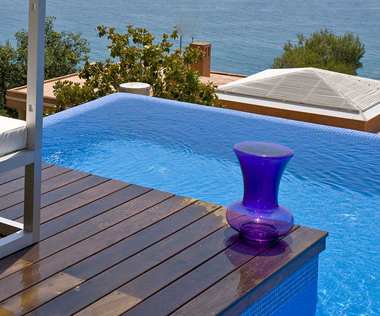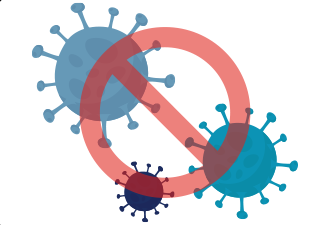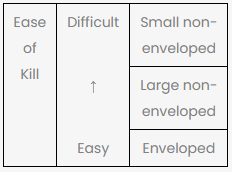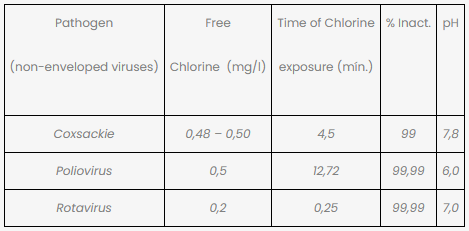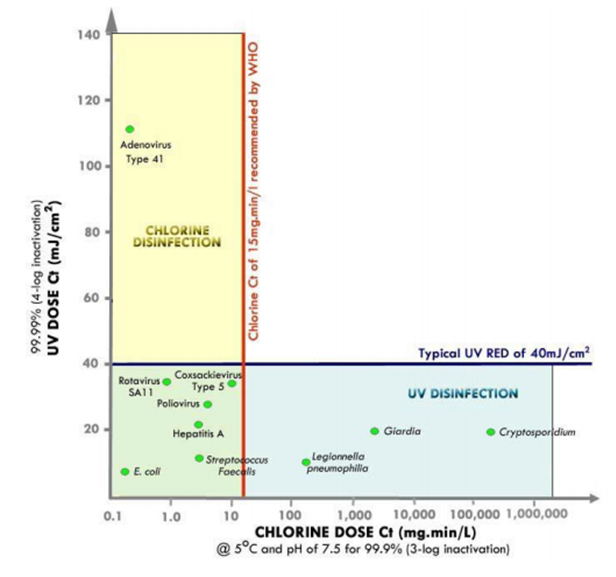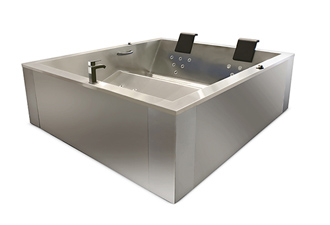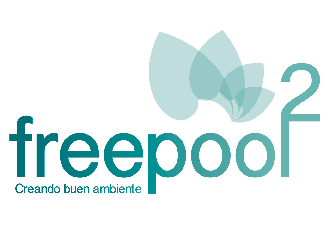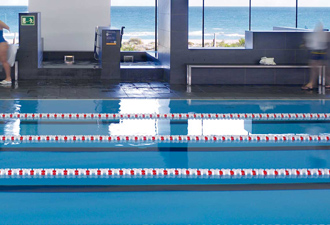In these times of uncertainty with the fear of the coronavirus being in many peoples’ minds, let’s have a look to swimming pools, their potential risks and the necessary pool water treatment to make sure the swimming pool is a safe place for us to be.
The main question everybody asks is:
1. If swimming pools are being chlorinated in accordance with current recommendations & best practices is this sufficient to inactivate COVID-19 virus? And, the additional one:
2. Should users be doing something they didn’t do before?
Having a look to the virus, SARS-CoV-2
Covid-19 is the respiratory illness caused by the virus SARS-CoV-2, that we all call Coronavirus. It is just one of the seven coronavirus that can infect human beings, like SARS (Severe Acute Respiratory Syndrome Coronavirus) and MERS (Middle East Respiratory Syndrome Coronavirus) 4.
This family of viruses have similar physical and biochemical properties and comparable transmission routes.
Virus genetic material is packaged inside protein structures called capsids. Viruses are divided into three groups depending if they are surrounded by an outer lipid membrane (enveloped) or not (non-enveloped) 5. Depending on their group, the difficulty to kill them varies.
Enveloped viruses are easier to kill: SARS-CoV-2, the virus responsible for the COVID-19 outbreak, is an enveloped virus and therefore the easiest to kill.
The World Health Organisation (WHO) states that a residual concentration of free chlorine of ≥0.5 mg/l in the pool water after at least 30 minutes of contact time at a pH <8.0 is sufficient to kill enveloped viruses like coronaviruses 2 .
In the Table there are some conditions in which more resistant viruses are inactivated.
Table: Inactivation of Viruses. CDC Organization7
The Diagram shows different efficacy levels to inactivate different viruses and pathogens. Coxsackievirus, Poliovirus and Rotavirus are examples of non-enveloped viruses. It can be seen that these are inactivated at chlorine Ct of less than 15mg-min/litre. (A Ct value is the product of the concentration of a disinfectant (e.g. free chlorine) and the contact time with the water being disinfected.)
Therefore an enveloped virus such as the COVID-19 virus would be situated in the green area of the Diagram and will be inactivated at even lower Ct values.
As shown on the Diagram, UV disinfection amplifies the efficacy spectrum considerably against other viruses.
Ultraviolet light has the ability to destroy the genome (DNA / RNA) of viruses, bacteria, and fungi, including coronaviruses. Standard disinfectants are effective against SARS-CoV-2 but as an extra level of protection, and/or to shield against possible errors in the manual disinfection process, ultraviolet light can be used to disinfect pool water after the chemical disinfection process is completed.8
Conclusions
Answer to Question 1: If swimming pools are being chlorinated in accordance with current recommendations & best practices is this sufficient to inactivate COVID-19 virus?
Yes, for a conventional swimming pool with good hydraulics and filtration, operating within its design bathing load, adequate water quality is achieved with a free chlorine level of ≥0.5-1 mg/l throughout the pool.
This means: with a free chlorine level of ≥0.5-1 mg/l the water is not only disinfected, it also has a disinfecting potential to tackle with any virus or germ which may be taken into the water. 9
Discover our disinfection products
Automation is very recommendable for ease of mind. (Otherwise the person in charge of the pool bears all the responsibility for the users’ health.)
Routine measurement of the main values is essential (pH value and free chlorine level (DPD-1); it may be carried out manually or automatically.
Residential Pools and semi-public pools:
The correct level of free chlorine in the pool water can be reached by dosing solid chlorine tablets or liquid chlorine chemical products. An automation of this dosing & regulation process is possible and highly recommended. Another good alternative is to use Salt Water Chlorination devices that generate automatically active free chlorine from dissolved salt in the pool water.
To amplify the spectrum of disinfection, as an extra level of protection, and to shield against possible errors in the manual disinfection process, ultraviolet light (UV) can be installed to disinfect pool water (in combination with either chlorine dosing or salt chlorination).
Automation is very much recommended mainly in semi-public pools, which use to have a higher bather load than residential pools, as well as automatic online measurement of the main values by a smart pool analyzer.
Publicly-used commercial pools:
To maximise safety, the recommendation is an automation of all three steps: the pH-value regulation (1), the disinfection (2) and the continuous measurement (3).
(1) A correct pH value regulation between 7.2 and 7.6 with acids or by means of CO2 will be essential to guarantee the effectiveness of disinfection.
(2) To amplify the spectrum of disinfection, the use of UV is highly recommended in combination with either chlorine dosing or salt chlorination.
(3) Continuous measurement of pH and chlorine levels and an automatic regulation of these parameters is a must in public pools. Recommendation: Display the values to the users, so they are fully informed about the water’s quality.
Answer to Question number 2: Should the users be doing something else?
As in our daily life we recommend maintaining adequate personal hygiene. For example, if there may be a risk of having touched surfaces such as changing room benches, doors or knobs, it is advisable to wash your hands and / or sanitize them with disinfectant before entering the pool. We recommend bathers to always shower before and after swimming in the pool. It is also recommended to wash suits and bath towels, to eliminate all bacteria or viruses.
In addition to the pool water, it is recommended to keep the surrounding areas of the pool disinfected, as well as its equipment, such as showers, ladders, etc. applying products specially indicated for this use.
REFERENCES
- Guidelines for the quality of drinking water, fourth edition, which incorporates the first addendum. Geneva, World Health Organization; 2017 ( http://apps.who.int/iris/bitstream/10665/254637/1/9789241549950-eng.pdf, accessed 3 March 2020 )
- Water, sanitation, hygiene and waste management for COVID-19. Technical report. March 19, 2020. ( https://www.who.int/publications-detail/water-sanitation-hygiene-and-waste-management-for-covid-19 )
- PWTAG Code of Practice for Swimming Pool Water – 2016 Updated to reflect requirements for health and safety management in swimming pools (HSG179) jimbutterworth.co.uk/2pwtag.pdf
- https://www.wef.org/news-hub/wef-news/the-water-professionals-guide-to-the-2019-novel-coronavirus/ accessed 2 March 2020
- How to choose effective disinfectants against the coronavirus that causes COVID-19. ( https://www.infectioncontroltoday.com/environmental-services/select-effective-disinfectants-use-against-novel-virus-covid-19) accessed 2 March 2020 )
- Environmental Protection Agency Manual Disinfection and Water Treatment Guidance, 2011. ( https://www.epa.ie/pubs/advice/drinkingwater/Disinfection2_web.pdf )
- Effects of chlorination in the deactivation of the selected pathogen. US Centers for Disease Control and Prevention ( https://www.cdc.gov/safewater/effectiveness-on-pathogens.html )
- About UV disinfection. ( https://www.researchgate.net/publication/339887436 )
- About hydrogen peroxide, known as liquid active oxygen, in the swimming pool market ( https://www.ncbi.nlm.nih.gov/pubmed/203115 ): “H2O2 at a concentration of 3% deactivated all the study virus in a time span of between 1 and 30 minutes. The viruses that cause the Coronavirus and the flu turned out to be the most sensitive. Reoviruses, adenoviruses and adeno-associated viruses were relatively stable. H2O2 is an effective means of inactivating the virus .” Recommended concentration in pool water: 10 – 30 ppm H2O2.
Potassium monopersulfate, known as solid active oxygen for swimming pools , respecting the recommended concentration of 5 – 10 ppm KMPS in water is also effective against the virus. ( https://www.epa.gov/pesticide-registration/list-n-disinfectants-use-against-sars-cov-2 )
Bromine in its different forms (Br2, BrCl, HOBr-) is used in swimming pools and spas (jacuzzi). Bromine has been used to inactivate bacteria, viruses, and protozoa in various laboratory disinfection studies (Kim, 2014). ( https://www.who.int/water_sanitation_health/publications/bromine-02032018.pdf?ua=1 ) Recommended residual levels: 1-3 ppm in residential pools; 3-5 ppm in residential spas.
Other references:
Guidelines for safe environments in recreational waters. Volume 2. Swimming pools and similar environments. WHO Publication, 2006. ( https://www.who.int/water_sanitation_health/publications/safe-recreational-water-guidelines-2/en/ )

